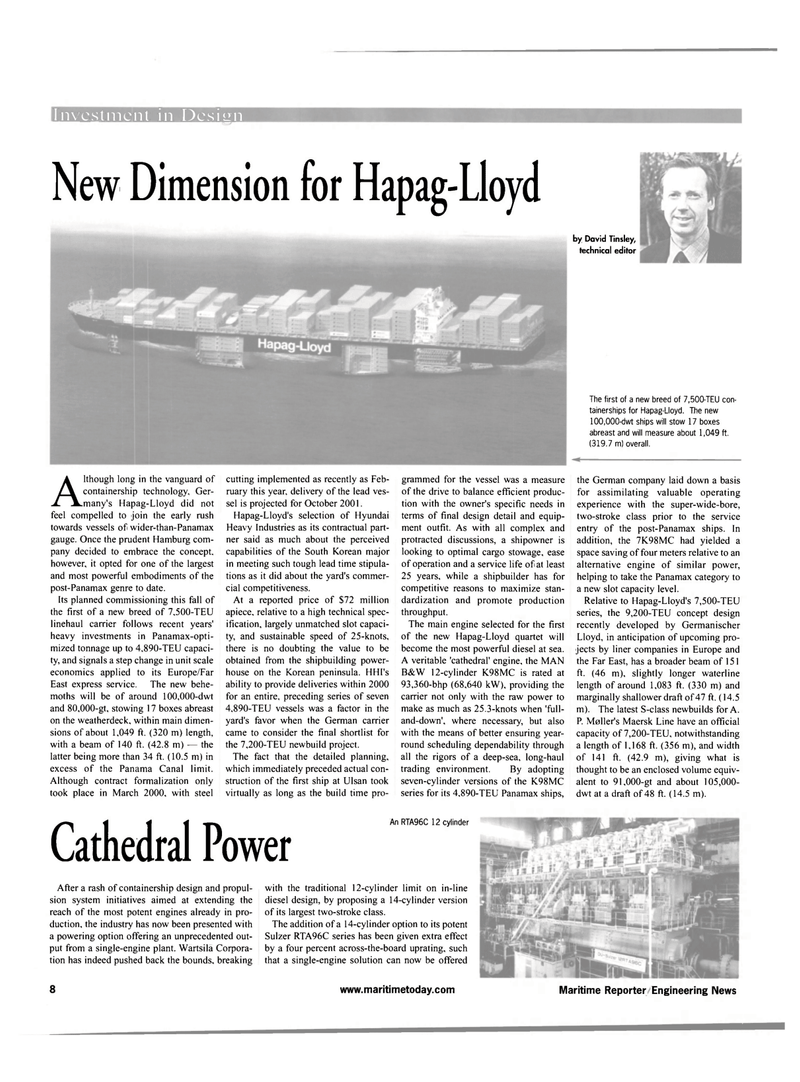
Page 8: of Maritime Reporter Magazine (May 2001)
Read this page in Pdf, Flash or Html5 edition of May 2001 Maritime Reporter Magazine
Investment in Desiun
New Dimension for Hapag-Lloyd
Although long in the vanguard of containership technology, Ger-many's Hapag-Lloyd did not feel compelled to join the early rush towards vessels of wider-than-Panamax gauge. Once the prudent Hamburg com- pany decided to embrace the concept, however, it opted for one of the largest and most powerful embodiments of the post-Panamax genre to date.
Its planned commissioning this fall of the first of a new breed of 7,500-TEU linehaul carrier follows recent years' heavy investments in Panamax-opti- mized tonnage up to 4,890-TEU capaci- ty, and signals a step change in unit scale economics applied to its Europe/Far
East express service. The new behe- moths will be of around 100,000-dwt and 80,000-gt, stowing 17 boxes abreast on the weatherdeck, within main dimen- sions of about 1,049 ft. (320 m) length, with a beam of 140 ft. (42.8 m) the latter being more than 34 ft. (10.5 m) in excess of the Panama Canal limit.
Although contract formalization only took place in March 2000, with steel cutting implemented as recently as Feb- ruary this year, delivery of the lead ves- sel is projected for October 2001.
Hapag-Lloyd's selection of Hyundai
Heavy Industries as its contractual part- ner said as much about the perceived capabilities of the South Korean major in meeting such tough lead time stipula- tions as it did about the yard's commer- cial competitiveness.
At a reported price of S72 million apiece, relative to a high technical spec- ification, largely unmatched slot capaci- ty, and sustainable speed of 25-knots, there is no doubting the value to be obtained from the shipbuilding power- house on the Korean peninsula. HHI's ability to provide deliveries within 2000 for an entire, preceding series of seven 4,890-TEU vessels was a factor in the yard's favor when the German carrier came to consider the final shortlist for the 7,200-TEU newbuild project.
The fact that the detailed planning, which immediately preceded actual con- struction of the first ship at Ulsan took virtually as long as the build time pro- by David Tinsley, technical editor grammed for the vessel was a measure of the drive to balance efficient produc- tion with the owner's specific needs in terms of final design detail and equip- ment outfit. As with all complex and protracted discussions, a shipowner is looking to optimal cargo stowage, ease of operation and a service life of at least 25 years, while a shipbuilder has for competitive reasons to maximize stan- dardization and promote production throughput.
The main engine selected for the first of the new Hapag-Lloyd quartet will become the most powerful diesel at sea.
A veritable 'cathedral' engine, the MAN
B&W 12-cylinder K98MC is rated at 93,360-bhp (68,640 kW), providing the carrier not only with the raw power to make as much as 25.3-knots when 'full- and-down', where necessary, but also with the means of better ensuring year- round scheduling dependability through all the rigors of a deep-sea, long-haul trading environment. By adopting seven-cylinder versions of the K98MC series for its 4,890-TEU Panamax ships,
The first of a new breed of 7,500-TEU con- tainerships for Hapag-Lloyd. The new 100,000-dwt ships will stow 17 boxes abreast and will measure about 1,049 ft. (319.7 m) overall. the German company laid down a basis for assimilating valuable operating experience with the super-wide-bore, two-stroke class prior to the service entry of the post-Panamax ships. In addition, the 7K98MC had yielded a space saving of four meters relative to an alternative engine of similar power, helping to take the Panamax category to a new slot capacity level.
Relative to Hapag-Lloyd's 7,500-TEU series, the 9,200-TEU concept design recently developed by Germanischer
Lloyd, in anticipation of upcoming pro- jects by liner companies in Europe and the Far East, has a broader beam of 151 ft. (46 m), slightly longer waterline length of around 1,083 ft. (330 m) and marginally shallower draft of 47 ft. (14.5 m). The latest S-class newbuilds for A.
P. Moller's Maersk Line have an official capacity of 7,200-TEU, notwithstanding a length of 1,168 ft. (356 m), and width of 141 ft. (42.9 m), giving what is thought to be an enclosed volume equiv- alent to 91,000-gt and about 105,000- dwt at a draft of 48 ft. (14.5 m).
Cathedral Power An RTA96C 12 cylinder
After a rash of containership design and propul- sion system initiatives aimed at extending the reach of the most potent engines already in pro- duction, the industry has now been presented with a powering option offering an unprecedented out- put from a single-engine plant. Wartsila Corpora- tion has indeed pushed back the bounds, breaking 8 with the traditional 12-cylinder limit on in-line diesel design, by proposing a 14-cylinder version of its largest two-stroke class.
The addition of a 14-cylinder option to its potent
Sulzer RTA96C series has been given extra effect by a four percent across-the-board uprating, such that a single-engine solution can now be offered www.maritimetoday.com Maritime Reporter & Engineering News

 7
7

 9
9
